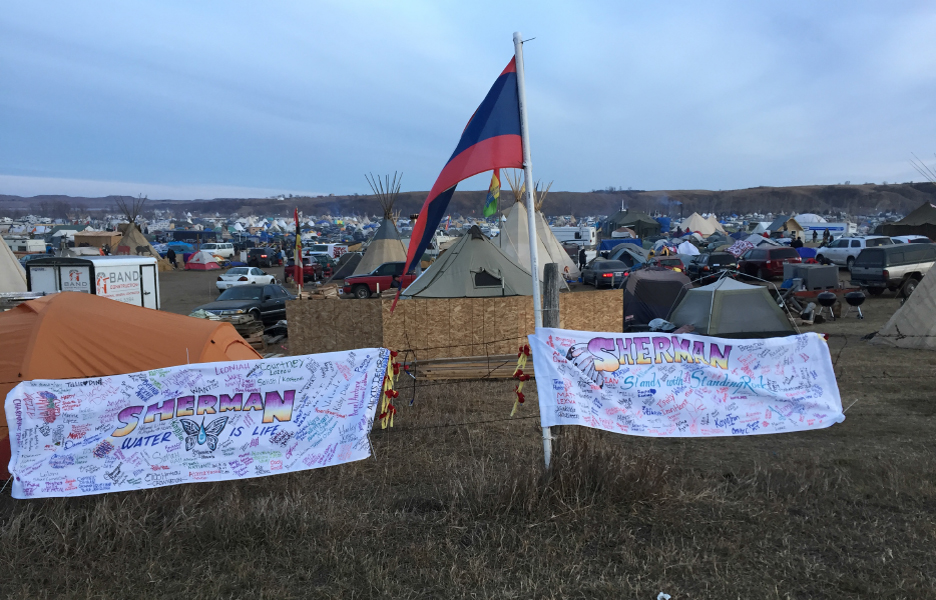By Alicia Cox, Department of Comparative Literature
Mohawk scholar Taiaiake Alfred claims that philosophies of power and nature most clearly exemplify the contrast between indigenous and dominant Western traditions. Whereas indigenous philosophies regard power as flowing from respect for nature and humanity’s place within the natural order, in Western philosophy power derives from coercion, artifice, and alienation from nature. Indeed, urban denizens often think of nature as a place one visits, for example, on a hike through the forest, rather than as a ubiquitous force on which all life depends. As a scholar of Native American and indigenous literatures, I’ve learned that the concepts of respect, responsibility, and reciprocity unite various indigenous peoples’ beliefs regarding humanity’s place in nature. As stewards of the land, humans are responsible for maintaining balance by practicing reciprocity: never take without giving something in return, and only take what is needed. The practice of reciprocity also requires us to respect our non-human relatives. Thankfully, genetic science is catching up to indigenous knowledge by “discovering” that humans share common ancestry with oak trees, wolves, sharks, butterflies, and sparrows, to name a few of our cousins.
The earth is our mother; that is a fact, not a metaphor. Unfortunately, the economic system of capitalism fails to recognize this truth. Private land ownership and natural resource extraction for unrestrained development, consumerism, and profit are unjustifiable according to indigenous philosophies. The trope of the naïve, nature-loving Indian who stands in the way of modern progress continues to characterize mainstream representations of indigenous people’s struggles with the ongoing system of settler colonialism. The Standing Rock Sioux Tribe’s current struggle to protect their lives, land, and water from the Dakota Access Pipeline (DAPL) is a case in point. Corporations and banks (including their investors and account holders) fund extraction economies that disproportionately target indigenous people’s lands and resources. A clear example of this environmental racism is the fact that the original location of DAPL was near the town of Bismarck, ND, but when Bismarck’s mostly white population raised concerns about potential oil spills that could contaminate their water supply, Dakota Access, LLC rerouted the pipeline to cross the Missouri River half a mile north of the Standing Rock reservation.
The Standing Rock Sioux people have a genealogical relationship to the lands where they reside. Sacred Stone Camp founder Ladonna Brave Bull Allard has explained that she is determined to remain in her home place because her roots grow out of her feet and right into the ground, her ancestors are buried there, everyone she sees is her relative, and she can’t
imagine living anywhere else. Her words echo Suquamish Chief Seattle’s famous statement given in 1854 in response to the United States government’s request to purchase a portion of the Suquamish people’s homelands: “The earth does not belong to man; man belongs to the earth.” Allard belongs to the land of her ancestors, and she is responsible for stewarding the land for future generations.
When I visited the Oceti Sakowin camp, I remembered that the knowledge one acquires from being present in a place is not attainable from reading the news or watching live feed videos. I don’t represent the #NoDAPL movement; I can only share my experience as one of thousands of water protectors who were present during my limited four-day stay in November 2016. The large “KEEP OFF” signs near the base of the hills demanded that visitors respect sacred sites and not walk on the burial mounds. The 3:00 a.m. wake-up calls reminded campers of our responsibility to greet the dawn with gratitude prayers and walk to the riverbank for a sunrise ceremony. Campers practiced reciprocity by bringing customary offerings to their hosts and doing their share of chores to keep the camp running smoothly.
Now that the construction of DAPL has been completed, it’s easy to feel discouraged. The Standing Rock Sioux tribe continues its struggle for justice via lawsuits that are working their way through the court system. What can the rest of us do to protect the water from the inevitable failure of manmade infrastructure? In addition to divesting from banks like Wells Fargo that fund DAPL and the fossil fuel industry, we must work to protect the water where we live. Some local waterways that need help to restore nature’s balance include: the ocean surrounding the San Onofre Nuclear Generating Station, the Salton Sea, the Sacramento River, and the Kuruvungna Springs. Consider your place. If you are not indigenous to the land you occupy, how can you be a good neighbor and guest? If you live in Orange County or Los Angeles County, you can learn about the local indigenous peoples, the Acjachemen/Juaneño (
www.juaneno.com) and Tongva/Gabrielino (
www.tongvapeople.org), and get involved with efforts to steward the land and protect the water where you live.
Alicia Cox is assistant professor of comparative literature. Her research focuses on American Indian narratives, decolonization and queer studies. She is currently completing a book on the autobiographies of three Hopi Indians who attended either Sherman Institute in Riverside or Phoenix Indian School in Arizona between 1906 and 1909. The autobiographies are written in the as-told-to genre, with individual oral histories recorded by non-Indians.


